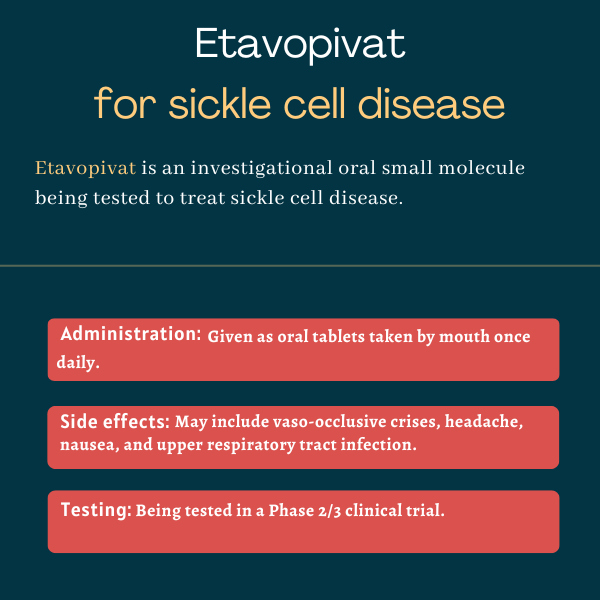Etavopivat for sickle cell disease
Last updated June 29, 2024, by Margarida Maia, PhD

What is etavopivat for sickle cell disease?
Etavopivat, formerly FT-4202, is an investigational oral small molecule being developed to treat people with sickle cell disease (SCD).
Developed by Forma Therapeutics, etavopivat has been granted fast track, rare pediatric disease, and orphan drug designations in the U.S. It also has been granted orphan drug status in Europe. Its clinical development has transitioned fully to Novo Nordisk after the company acquired Forma in 2022.
Therapy snapshot
| Treatment name: | Etavopivat |
| Administration: | Being tested as oral tablets taken by mouth in sickle cell disease |
| Clinical testing: | In Phase 2/3 clinical testing |
How does etavopivat work in sickle cell disease?
SCD is caused by mutations in the HBB gene that result in the production of a faulty version of hemoglobin, the protein in red blood cells that carries oxygen and delivers it to tissues in the body. The faulty version doesn’t bind to oxygen as well and tends to clump together into rigid threads that bend red blood cells into a sickle-like shape.
Sickle-shaped red blood cells are fragile and more likely to die prematurely, which can lead to anemia, or too few healthy red blood cells. They also tend to stick to the lining of blood vessels, which can slow or block blood flow to tissues. As a result, patients have a broad range of symptoms, including frequent episodes of acute pain known as vaso-occlusive crises (VOCs).
As a response to anemia, the body increases the production of 2,3-diphosphoglycerate (2,3-DPG), a molecule that helps offload oxygen into tissues, causing more faulty hemoglobin to clump together. Reducing the levels of 2,3-DPG would let oxygen bind more tightly to its carrier protein, making it less likely to clump together.
Etavopivat is a small molecule activator of the enzyme pyruvate kinase R (PKR). In its active state, PKR pushes red blood cells to produce energy and 2,3-DPG levels to drop. By reducing the levels of 2,3-DPG and increasing the production of energy, etavopivat should allow stronger binding of oxygen to the faulty hemoglobin protein. This would prevent red blood cells from taking on a sickle-like shape, thereby prolonging red blood cell survival, easing anemia, and reducing VOC frequency.
How will etavopivat be administered in sickle cell disease?
In Phase 2 and Phase 2/3 clinical trials involving SCD patients, etavopivat has been given as tablets taken by mouth once daily at 200 or 400 mg.
Etavopivat in sickle cell disease clinical trials
A Phase 1 clinical trial (NCT03815695) tested how safe and well tolerated etavopivat was against a placebo in 90 healthy adults and 36 adults and adolescents, ages 15-64, with SCD. It also evaluated etavopivat’s pharmacokinetics, that is, how it moves into, through, and out of the body, when given as a single or multiple ascending doses, and how well it works to reduce the levels of 2,3-DPG and increase energy production.
In healthy adults, most side effects of etavopivat were mild and the therapy was well tolerated when given at doses of up to 700 mg. Etavopivat was taken rapidly into the bloodstream and its levels decreased steadily over time after single or multiple doses of up to 400 mg. Dosing of etavopivat for 14 days resulted in a reduction of 2,3-DPG of nearly 60% at doses ranging from 100 to 300 mg twice daily or 400 mg once daily. The effects lasted for more than a day after the last dose, suggesting the therapy could be taken just once a day. At the same time, there was an increase in the levels of adenosine triphosphate (ATP), the molecule that cells use to store and transfer energy. The maximal increase occurred between 8-14 days of repeated dosing and lasted for up to three days after the last dose. Food did not affect how well etavopivat worked.
Testing in adults and adolescents with SCD was done in stages. First, seven patients received a single dose of either 700 mg of etavopivat or a placebo. Next, 20 patients were assigned to receive daily doses of 300 or 600 mg of etavopivat, or a placebo, for 14 days. During an open-label and final stage, 15 patients received daily doses of 400 mg of etavopivat for up to 12 weeks, or about three months.
Most side effects were mild, but five patients had serious side effects. The most common treatment-related side effect was VOCs. The mean half-life of etavopivat, that is, the time taken for its levels to fall to half of the original value, was about 17 hours for the 700 mg single dose and about 4-5 hours for the lower dose strengths. Treatment with etavopivat for up to 12 weeks resulted in a reduction of 2,3-DPG of about 30%, whereas the levels of ATP nearly doubled. Nearly three-quarters (73.3%) of patients had a hemoglobin increase greater than 1 g/dL at any time during the 12 weeks of treatment. Red blood cells were less likely to take on a sickle-like shape. The number of reticulocytes, immature red blood cells that indicate red blood cells are being destroyed, also decreased significantly.
Ongoing clinical trials
An open-label Phase 2 clinical trial, called GLADIOLUS (NCT04987489), is testing the safety and efficacy of etavopivat in adults and adolescents with SCD who require regular red blood cell transfusions, or thalassemia, a blood disease that occurs when not enough hemoglobin is produced. It plans to recruit 60 patients, ages 12-65, at sites in the U.S., Canada, and Lebanon. Its main goal is to assess how well etavopivat, given once a day at 400 mg works at lowering the number of red blood cell transfusions and increasing levels of hemoglobin in the blood over 12 weeks, or about three months.
Testing is also ongoing in a larger Phase 2/3 clinical trial called HIBISCUS (NCT04624659), where up to 344 adults and adolescents with SCD, ages 12-65, are expected to be enrolled. Patients will be randomly assigned to receive either 200 or 400 mg of etavopivat once daily, or a placebo. At the first interim analysis, one of the two doses of etavopivat will be selected for the next phase, in which patients will receive either the selected dose of etavopivat or a placebo. Patients who complete 52 weeks (one year) of treatment may enter an open-label extension where all may receive etavopivat for an additional 52 weeks. The trial’s main goal is to test how well etavopivat works compared with a placebo to increase the levels of hemoglobin in the blood after 24 weeks (about six months) and to reduce the number of VOCs over a year.
Other ongoing clinical trials in adolescents
A Phase 1/2 clinical trial (NCT06198712) is testing the safety and efficacy of etavopivat in up to 50 adolescents with SCD, ages 12-18. Patients will take etavopivat as tablets once daily for 96 weeks, or nearly two years. The last visit will take place four weeks after the end of treatment. Its main goal is to test how safe etavopivat is and how long etavopivat stays in the bloodstream.
An open-label Phase 2 clinical trial (NCT05953584) is testing etavopivat in up to 46 adolescents with SCD, ages 12-16, who are at an increased risk of having a stroke, which occurs when the blood supply to a part of the brain is blocked or reduced and is common in children with the condition. Patients will receive 400 mg of etavopivat once daily with or without hydroxyurea, a medication that’s approved to reduce the frequency of VOCs associated with SCD. The study’s main goal is to watch for changes in how fast blood flows through specific blood vessels in the brain over 12 weeks using a specialized type of ultrasound that uses sound waves to detect issues in blood flow in the brain.

Common side effects of etavopivat
Side effects reported with etavopivat during clinical testing in SCD patients include:
- vaso-occlusive crises
- headache
- nausea
- upper respiratory tract infection.
Sickle Cell Disease News is strictly a news and information website about the disease. It does not provide medical advice, diagnosis, or treatment. This content is not intended to be a substitute for professional medical advice, diagnosis, or treatment. Always seek the advice of your physician or other qualified health provider with any questions you may have regarding a medical condition. Never disregard professional medical advice or delay in seeking it because of something you have read on this website.
Recent Posts
- Dosing started in Phase 1 study of globin-switching therapy CLY-124
- What I’ve learned about life, love, and sacrifice due to caregiving
- ED pain scores may predict future hospitalization for SCD children
- What to consider before making a change to your treatment regimen
- Buprenorphine may reduce opioid use for sickle cell disease patients
- Reflecting on 4 years of sharing my experiences with sickle cell
- Level of physical activity tied to less pain, blood viscosity in SCD: Study
- Celebrating ourselves is a way to promote sickle cell awareness
- BEAM-101 shows sustained benefits as treatment for sickle cell
- Attending a hematology conference as a sickle cell patient is empowering
Related articles






